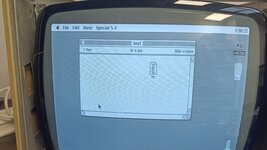So, next step was getting the floppydrive back to life.
As to be expected, all the grease from the metal moving parts was completely gummed up, even the grease on the plastic gears from the eject motor was totally hardened out.
Took apart what needed to be taken apart to get to the moving parts, got all the old grease out as best as I could.
Cleaned the head with a bit of IPA on an cotton bud.
Then, time to test. First time powered up, the stepper motor for the head pushed the head assembly all the way out and kept turning, with a tack-tack-tack noise.
In doubt what the issue was, the only thing I could imagine was the optic eye thinking the drive assembly was at the other end.
So cleaned the space between the led and the pick up with some paper towel and IPA around a thin piece of cardboard...
Not sure that actually was the cause, but next try the motor did not go haywire, and the Lisa booted up normally.
Putting a floppy in, the Lisa asked to initialize the disk, which it ended up doing correctly and asking me to name the floppy.
Moved some files back and forth, looks like it works just fine!
The test setup:

Viedo of the moving head assembly while initializing, as it is only single sided, you see only the part without head, but with a bit of felt pushing the floppy against the head on the other side.
Guess I now know why a double sided floppy used in a single sided drive stops being useable in a double sided 800k drive after a while, guess the felt does a number on the magnetic layer on that side of the floppy!
View attachment VID20230506155538.mp4



